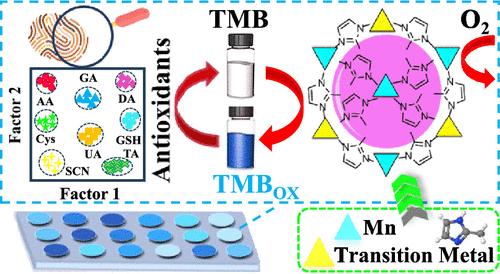Array of Manganese-Based Bimetallic Metal–Organic-Framework Nanozymes with Enhanced Oxidase-like Catalytic Activity Can Simultaneously Identify and Measure Antioxidants
IF 6.7
1区 化学
Q1 CHEMISTRY, ANALYTICAL
引用次数: 0
Abstract
Developing sensitive and highly active nanozymes for antioxidant analysis is of the utmost significance in medical diagnosis and health monitoring due to their essential roles as free reactive oxygen species scavengers. Here, six metal–organic frameworks (MOFs)-based nanozymes are developed as a dual-mode absorbance/image analysis colorimetric sensor array for simultaneous discrimination and determination of various antioxidants with comparable structural or chemical properties. The catalysts exhibit a wide range of highly potent oxidase-like catalytic activities, as verified by kinetic parameters, due to the presence of highly dispersed transition metallic and bimetallic redox nodes. These nanozymes efficiently catalyze the oxidation of colorless 3,3′,5,5′-tetramethylbenzidine (TMB) to blue TMBox, resulting in noticeable absorption and RGB color changes at 650 nm. Various antioxidants demonstrate different reducing capabilities to TMBox, leading to the generation of fingerprint-like spectral color patterns. The pattern recognition chemometrics methods including principal component analysis (PCA) and linear discriminant analysis (LDA) represent well-separated clustering and discrimination of ascorbic acid, dopamine, uric acid, cysteine, glutathione, thiocyanate, tannic acid, and gallic acid. The colorimetric assay provides a wide linear detection range (0.1–75 μM) and detection limits as low as 30 nM. The sensor array successfully discriminated antioxidants of various concentrations, mixtures, and potent interferences. Furthermore, the sensor’s applicability in biologically relevant detection was validated in urine and plasma samples. Overall, the MOF-based nanozyme sensor array offers a promising platform for discriminating and determining a wide range of antioxidants with potential applications.

具有增强氧化酶催化活性的锰基双金属金属-有机框架纳米酶阵列可以同时识别和测量抗氧化剂
开发灵敏、高活性的纳米酶用于抗氧化分析在医学诊断和健康监测中具有重要意义,因为它们是游离活性氧清除剂的重要作用。本文开发了六种基于金属有机框架(mof)的纳米酶作为双模式吸光度/图像分析比色传感器阵列,用于同时识别和测定具有相似结构或化学性质的各种抗氧化剂。由于存在高度分散的过渡金属和双金属氧化还原节点,该催化剂表现出广泛的高效氧化酶样催化活性,正如动力学参数所证实的那样。这些纳米酶有效地催化无色的3,3 ',5,5 ' -四甲基联苯胺(TMB)氧化为蓝色TMBox,在650 nm处产生明显的吸收和RGB颜色变化。各种抗氧化剂对TMBox表现出不同的还原能力,从而产生类似指纹的光谱颜色图案。包括主成分分析(PCA)和线性判别分析(LDA)在内的模式识别化学计量学方法对抗坏血酸、多巴胺、尿酸、半胱氨酸、谷胱甘肽、硫氰酸盐、单宁酸和没食子酸进行了良好的聚类和区分。该比色法具有宽的线性检测范围(0.1 ~ 75 μM),检出限低至30 nM。传感器阵列成功地区分了各种浓度、混合物和强干扰的抗氧化剂。此外,该传感器在生物相关检测中的适用性在尿液和血浆样本中得到了验证。总的来说,基于mof的纳米酶传感器阵列为鉴别和确定广泛的抗氧化剂提供了一个有前景的平台,具有潜在的应用前景。
本文章由计算机程序翻译,如有差异,请以英文原文为准。
求助全文
约1分钟内获得全文
求助全文
来源期刊

Analytical Chemistry
化学-分析化学
CiteScore
12.10
自引率
12.20%
发文量
1949
审稿时长
1.4 months
期刊介绍:
Analytical Chemistry, a peer-reviewed research journal, focuses on disseminating new and original knowledge across all branches of analytical chemistry. Fundamental articles may explore general principles of chemical measurement science and need not directly address existing or potential analytical methodology. They can be entirely theoretical or report experimental results. Contributions may cover various phases of analytical operations, including sampling, bioanalysis, electrochemistry, mass spectrometry, microscale and nanoscale systems, environmental analysis, separations, spectroscopy, chemical reactions and selectivity, instrumentation, imaging, surface analysis, and data processing. Papers discussing known analytical methods should present a significant, original application of the method, a notable improvement, or results on an important analyte.
 求助内容:
求助内容: 应助结果提醒方式:
应助结果提醒方式:


